Hammerfest Municipality
Hammerfest kommune Hámmerfeastta suohkan | |
|---|---|
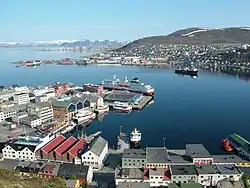 View of Hammerfest in mid-June 2005 | |
 Flag | |
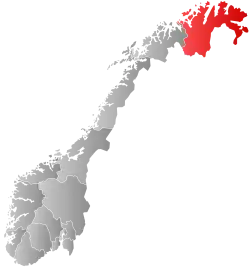 Finnmark within Norway | |
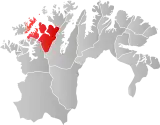 Hammerfest within Finnmark | |
| Coordinates: 70°39′45″N 23°41′00″E / 70.66250°N 23.68333°E | |
| Country | Norway |
| County | Finnmark |
| District | Vest-Finnmark |
| Established | 1 Jan 1838 |
| • Created as | Formannskapsdistrikt |
| Administrative centre | Hammerfest |
| Government | |
| • Mayor (2023) | Terje Rogde (H) |
| Area | |
| • Total | 2,693.05 km2 (1,039.79 sq mi) |
| • Land | 2,557.83 km2 (987.58 sq mi) |
| • Water | 134.98 km2 (52.12 sq mi) 5% |
| • Rank | #19 in Norway |
| Population (2023) | |
| • Total | 11,310 |
| • Rank | #103 in Norway |
| • Density | 4.4/km2 (11/sq mi) |
| • Change (10 years) | |
| Demonym | Hammerfesting[1] |
| Official language | |
| • Norwegian form | Neutral |
| Time zone | UTC+01:00 (CET) |
| • Summer (DST) | UTC+02:00 (CEST) |
| ISO 3166 code | NO-5603[3] |
| Website | Official website |
Hammerfest (ⓘ; Northern Sami: Hámmerfeasta [ˈhaːmmerˌfea̯sːta]) is a municipality in Finnmark county, Norway. Hammerfest is the northernmost town in the world with more than 10,000 inhabitants, with the administrative centre of the municipality being the town of Hammerfest. Some of the main villages in the municipality include Rypefjord, Kvalsund, Forsøl, Hønsebybotn, Akkarfjord i Kvaløya, Akkarfjord i Sørøya, and Kårhamn.
The 2,693-square-kilometre (1,040 sq mi) municipality is the 19th largest by area out of the 356 municipalities in Norway. Hammerfest is the 103rd most populous municipality in Norway with a population of 11,310. The municipality's population density is 4.4 inhabitants per square kilometre (11/sq mi) and its population has increased by 1.8% over the previous 10-year period.[4][5]
The municipality encompasses parts of three large islands: Kvaløya, Sørøya, and Seiland. Other small islands such as Håja, Lille Kamøya and Kamøya are also located here. Most parts of the municipality do not have a road connection with the rest of Norway; only Kvaløya island is connected to the mainland, via the Kvalsund Bridge.
General information
A municipality called Hammerfest by og landdistrikt (Hammerfest town and district) was established on 1 January 1838 (see formannskapsdistrikt law), which included the town of Hammerfest and the vast rural district surrounding it. The law at that time required that all towns should be separated from their rural districts, but because of low population and very few voters, this was impossible to carry out for Hammerfest in 1838. (This was also the case in the nearby towns of Vadsø and Vardø.) In 1839, the northern district (population: 498) was separated to become a new municipality of Maasø. This left Hammerfest by og landdistrikt with 2,024 residents. On 1 January 1852, the rural district outside of the town (population: 1,256) was separated from the town to form a new municipality of Hammerfest landdistrikt. This left the town with 1,125 residents. (The rural district was later divided into two municipalities with Sørøysund in the north and Kvalsund in the south.)
On 1 January 1992, the municipality of Sørøysund (population: 2,341) was merged with the town of Hammerfest (population: 6,909) to form a new, larger municipality called Hammerfest.[6]
In 2017, the two neighboring municipalities of Hammerfest and Kvalsund voted to merge into one large municipality effective 1 January 2020,[7] and that merger came into effect on the planned date. Also on the same day, the new municipality became part of the newly formed Troms og Finnmark county. Previously, it had been part of the old Finnmark county.[8]
On 1 January 2024, the Troms og Finnmark county was divided and the municipality once again became part of Finnmark county.[9]
Name
The municipality is named after the town of Hammerfest that was established in 1789. The town was named after an old anchorage. The first element of the name is derived from the local Hamran (Old Norse: Hamarr). Hamran were a number of large rocks, good for mooring boats in the local harbour. The name comes from the word hamarr which means "stone", "steep cliff", or "rock face". The local Hamran were covered up in land reclaiming during the early years after World War II. The last element of the name comes from the word festr which means "rope" or "fastening" (for boats).[10]

On 1 January 2020 when the old municipalities of Kvalsund and Hammerfest were merged, the new municipality chose two parallel, bilingual, interchangeable names: Hammerfest kommune (Norwegian) and Hámmerfeastta suohkan (Northern Sami).[11] The Sami language name spelling changes depending on how it is used. It is called Hámmerfeasta when it is spelled alone, but it is Hámmerfeastta suohkan when using the Sami language equivalent to "Hammerfest municipality".[12] Beside the official Hámmerfeasta, there are also two other common variants of the Sámi name: Hámmarfeasta and Hámmárfeasta.[13]
Coat of arms
The coat of arms was granted on 16 December 1938, in preparation for the celebration of the 150th anniversary of the town's establishment in 1939. The official blazon is "Gules, a polar bear statant argent" (Norwegian: En hvit isbjørn i rødt). This means the arms have a red field (background) and the charge is a polar bear. The polar bear has a tincture of argent which means it is commonly colored white, but if it is made out of metal, then silver is used. The polar bear was chosen as a symbol for the fishing in the polar seas north of Norway. The polar bear itself is not native to mainland Norway. Because of its town status, the arms often have a mural crown above them. The arms were designed by Ole Valle and the design was updated by Arvid Steen in 2001.[14][15][16]
Churches
The Church of Norway has three parishes (sokn) within the municipality of Hammerfest. It is part of the Hammerfest prosti (deanery) in the Diocese of Nord-Hålogaland.
| Parish (sokn) | Church name | Location of the church | Year built |
|---|---|---|---|
| Hammerfest | Hammerfest Church | Hammerfest | 1961 |
| Kvalsund | Kvalsund Church | Kvalsund | 1936 |
| Sennalandet Chapel | Áisaroaivi | 1961 | |
| Kokelv | Kokelv Church | Kokelv | 1960 |
History
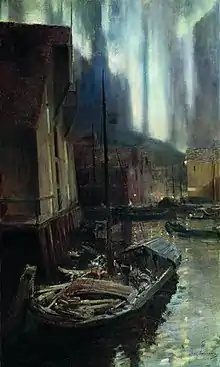
Many grave sites dating back to the Stone Age can be found here. This location was an important fishing and Arctic hunting settlement for a long time before it was given market town rights by royal decree of Christian VII of Denmark–Norway in 1789.
Napoleonic Wars
During the Napoleonic Wars, Denmark–Norway broke its neutrality after a Royal Navy fleet launched a pre-emptive attack on Copenhagen, allying with France against the Coalition. As one of the main centres of commerce and transportation in western Finnmark, Hammerfest became a target of the Royal Navy's naval blockade. Thus, upon the request of local merchants, the town received four six-pound cannons from the central armoury in Trondheim. Subsequently, a fifty-man strong coastal defence militia was formed to defend Hammerfest from a possible naval assault. A number of merchants formed the officer corps of the militia, while Sea Samis and Kvens were mobilized as gun crews and soldiers.
British attack
On 22 July 1809, the expected British attack came when the brigs HMS Snake and HMS Fancy approached the town. Before reaching Hammerfest, the two vessels had successfully attacked the village of Hasvik. The following battle between Hammerfest's two two-cannon batteries and the Royal Navy warships with a combined number of thirty-two cannon between them was unusually intense and did not end before the Norwegian cannons had run out of gunpowder after about 90 minutes of combat. Both warships had suffered a number of cannonball hits and had at least one fatal casualty; a sailor who was buried at the local cemetery. During the battle, the local populace evacuated the town, and the Snake and Fancy remained in the town for eight days after the Norwegian defenders withdrew. The crews sacked the empty town before withdrawing.
Improved fortifications
After the raid, Hammerfest became a garrison town with some regular troops and much improved and expanded fortifications. A small flotilla of cannon-armed rowing boats also operated out of Hammerfest for the remainder of the Napoleonic Wars.
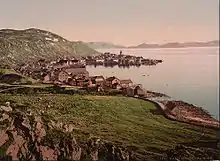
_aus_100_m_H%C3%B6he-Spitzbergenflug_1923-LBS_MH02-01-0058-AL-FL.tif.jpg.webp)
Fire of 1890
Hammerfest was struck by a fire in 1890 which started in the bakery and wiped out almost half the town's houses. After the fire Hammerfest received donations and humanitarian assistance from across the world, with the biggest single donor being Kaiser Wilhelm II of Germany. The Kaiser had personally visited the town several times on his yacht and had great affection for the small northern settlement.
Electric street lighting
In 1891, Hammerfest became the first urban settlement in Northern Europe to get electrical street lights.[17] The invention was brought to Hammerfest by two of the town's merchants who had seen it demonstrated at a fair in Paris.[18]
Destruction in World War II
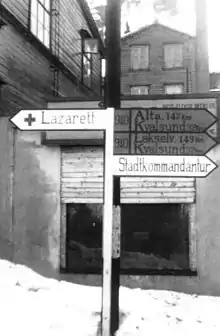
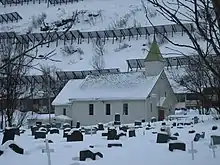
After their victory in the Norwegian Campaign of the Second World War, the Germans soon fortified Hammerfest and used it as a major base. The importance of Hammerfest to the Germans increased dramatically after their invasion of the Soviet Union in 1941. The occupiers installed three coastal batteries in and around Hammerfest, one with four 10.5 cm (4.1 in) guns on Melkøya island near the town, one with three 10.5 cm guns on a hill right outside the town and a final battery with casemated 13 cm (5.1 in) pieces on the Rypklubben peninsula near Rypefjord.
The main German U-boat base in Finnmark was in Hammerfest, serving as a central supply base for the vessels attacking the allied supply convoys to Russia.[19] Luftwaffe seaplanes were based at an improvised naval air station in nearby Rypefjord.[20] The garrison in Hammerfest was also protected by around 4,000 mines and numerous anti-aircraft guns.
During their long retreat following the Petsamo-Kirkenes Operation, the Germans no longer managed to transport troops by sea further east due to intensive Red Air Force raids. Thus Hammerfest became their main shipping port in Finnmark in the autumn of 1944.[21]
The town of Hammerfest was bombed twice by the Soviet Air Forces. The first time, on 14 February 1944, the town was hit by explosive and incendiary devices, but little damage was done. On 29 August 1944 Soviet bombers launched a second airstrike, inflicting significantly more damage to buildings and infrastructure in downtown Hammerfest. Two ships were sunk in the harbour.[22] The ships lost were the local transports Tanahorn and Brynilen.[23][24]
The population was forcibly evacuated by the occupying German troops in the autumn of 1944 after a Soviet offensive at the northern extremity of the Eastern Front pushed into eastern Finnmark. All of Finnmark including the town was looted and burned to the ground by the Germans when they retreated in 1945, the last of the town having been destroyed by the time the Germans finally left on 10 February 1945. Only the town's small funeral chapel, built in 1937, was left standing.[22] The Museum of Reconstruction in Hammerfest tells the story of these events and the recovery of the region. The Soviet troops in eastern Finnmark were withdrawn in September 1945.
Mines and munitions left over from the Second World War were found and destroyed as late as 2008.[25]
Geography

The island municipality encompasses parts of the mainland as well as three large islands: Kvaløya, Sørøya, and Seiland. Other small islands such as Lille Kamøya and Kamøya are also located here. Seiland National Park is partially located in the municipality. Seilandsjøkelen is a large glacier in the park. The Nordefjorden is a fjord that is part of the park. The mountains Komagaksla and Seilandstuva are some of the largest mountains in the municipality.
Hammerfest claims to be the northernmost city in the world, although the title is disputed by the nearby Norwegian town of Honningsvåg (achieved town status 1996). The validity of the claim depends upon one's definition of a city; although Hammerfest is further south than Honningsvåg it has a population over 10,000, which is required by Norwegian law to achieve town status (law from 1997). In retrospect, Parliament ruled that a city should be located in a municipality with at least 5,000 inhabitants. But the provision has not been made retroactive. Honningsvåg is the northernmost town today, in Norway.[26] Utqiagvik, Alaska, population c. 4,000, is further north than both the Norwegian towns, but does not lay claim to the title of northernmost town.[27] Some foreigners may find it strange that either Hammerfest or Honningsvåg claims to be cities, given the small size of both places and it may help to know that the Norwegian language does not distinguish between city and town. The closest translation for either term is the word by, meaning the translation from Norwegian to English is ambiguous. If both Hammerfest and Honningsvåg were to be defined according to old British tradition, neither of them would be considered cities, as neither has a cathedral. Both of them may, however, be considered towns, given the status of both settlements as economic hubs of the surrounding areas and the status as municipal centres.
Hammerfest is, together with Vardø, the oldest town in Northern Norway. The town of Hammerfest is situated on the island of Kvaløya, with road connection to the mainland using the Kvalsund Bridge.
Climate
Hammerfest has a subarctic climate (Köppen climate classification Dfc). In spite of the extreme northern location, there is no permafrost, as the mean annual temperature is approximately 2.5 °C (36 °F), about the same as Anchorage, Alaska which is located at a latitude of 61° North. Hammerfest often experiences heavy snowfall in winter, and on some occasions, avalanches or risk of avalanches have forced some inhabitants to be evacuated from their exposed homes until the danger was over.[28]
The "midnight sun" is above the horizon from 14 May to 31 July (79 days), and the period with continuous daylight lasts a bit longer, conversely the polar night lasts from 23 November to 19 January (59 days). The weather data is from Hammerfest Airport about 80 m elevation and 2 km from the town. Hammerfest town is at sea level, thus the town itself might be slightly warmer.
| Climate data for Hammerfest 1991–2020 normals, extremes 1957–present[lower-alpha 1] | |||||||||||||
|---|---|---|---|---|---|---|---|---|---|---|---|---|---|
| Month | Jan | Feb | Mar | Apr | May | Jun | Jul | Aug | Sep | Oct | Nov | Dec | Year |
| Record high °C (°F) | 8.0 (46.4) |
8.1 (46.6) |
9.8 (49.6) |
12.3 (54.1) |
23.4 (74.1) |
28.9 (84.0) |
29.7 (85.5) |
29.3 (84.7) |
20.2 (68.4) |
18.9 (66.0) |
10.0 (50.0) |
9.9 (49.8) |
29.7 (85.5) |
| Mean maximum °C (°F) | 4.8 (40.6) |
4.7 (40.5) |
5.1 (41.2) |
8.2 (46.8) |
15.1 (59.2) |
20.3 (68.5) |
24.4 (75.9) |
22.2 (72.0) |
17.1 (62.8) |
11.9 (53.4) |
7.6 (45.7) |
6.2 (43.2) |
24.8 (76.6) |
| Mean daily maximum °C (°F) | −1.3 (29.7) |
−1.6 (29.1) |
−0.2 (31.6) |
3.0 (37.4) |
7.3 (45.1) |
10.7 (51.3) |
15.3 (59.5) |
13.9 (57.0) |
10.4 (50.7) |
5.3 (41.5) |
2.4 (36.3) |
0.6 (33.1) |
5.5 (41.9) |
| Daily mean °C (°F) | −3.5 (25.7) |
−4.0 (24.8) |
−2.5 (27.5) |
0.1 (32.2) |
4.0 (39.2) |
7.6 (45.7) |
11.3 (52.3) |
10.6 (51.1) |
7.9 (46.2) |
2.9 (37.2) |
−0.4 (31.3) |
−1.8 (28.8) |
2.7 (36.9) |
| Mean daily minimum °C (°F) | −6.7 (19.9) |
−6.9 (19.6) |
−5.2 (22.6) |
−2.0 (28.4) |
1.9 (35.4) |
5.2 (41.4) |
8.9 (48.0) |
8.3 (46.9) |
5.7 (42.3) |
1.1 (34.0) |
−2.4 (27.7) |
−4.5 (23.9) |
0.3 (32.5) |
| Mean minimum °C (°F) | −14.1 (6.6) |
−13.9 (7.0) |
−11.6 (11.1) |
−8.4 (16.9) |
−3.4 (25.9) |
1.1 (34.0) |
5.2 (41.4) |
4.3 (39.7) |
1.3 (34.3) |
−5.2 (22.6) |
−8.9 (16.0) |
−11.0 (12.2) |
−16.2 (2.8) |
| Record low °C (°F) | −23.5 (−10.3) |
−23.0 (−9.4) |
−21.0 (−5.8) |
−16.5 (2.3) |
−14.3 (6.3) |
−4.3 (24.3) |
2.5 (36.5) |
0.0 (32.0) |
−8.2 (17.2) |
−15.0 (5.0) |
−18.1 (−0.6) |
−20.4 (−4.7) |
−23.5 (−10.3) |
| Average precipitation mm (inches) | 71 (2.8) |
65 (2.6) |
62 (2.4) |
60 (2.4) |
47 (1.9) |
52 (2.0) |
56 (2.2) |
60 (2.4) |
79 (3.1) |
93 (3.7) |
85 (3.3) |
90 (3.5) |
820 (32.3) |
| Average extreme snow depth cm (inches) | 74 (29) |
92 (36) |
105 (41) |
103 (41) |
70 (28) |
9 (3.5) |
0 (0) |
0 (0) |
1 (0.4) |
13 (5.1) |
28 (11) |
54 (21) |
126 (50) |
| Average precipitation days (≥ 1.0 mm) | 15 | 13 | 13 | 12 | 10 | 12 | 11 | 12 | 15 | 16 | 15 | 16 | 160 |
| Average relative humidity (%) | 76 | 76 | 76 | 75 | 74 | 76 | 77 | 80 | 79 | 80 | 79 | 77 | 77 |
| Average dew point °C (°F) | −7.7 (18.1) |
−7.9 (17.8) |
−6.2 (20.8) |
−3.3 (26.1) |
0.2 (32.4) |
3.8 (38.8) |
7.6 (45.7) |
7.1 (44.8) |
5.1 (41.2) |
0.2 (32.4) |
−3.1 (26.4) |
−4.9 (23.2) |
−0.8 (30.6) |
| Source 1: Norwegian Meteorological Institute[lower-alpha 2][29][30][31] | |||||||||||||
| Source 2: NOAA WMO averages 91-2020 Norway[32] | |||||||||||||
Government
All municipalities in Norway are responsible for primary education (through 10th grade), outpatient health services, senior citizen services, welfare and other social services, zoning, economic development, and municipal roads and utilities. The municipality is governed by a municipal council of directly elected representatives. The mayor is indirectly elected by a vote of the municipal council.[33] The municipality is under the jurisdiction of the Vestre Finnmark District Court and the Hålogaland Court of Appeal.
Municipal council
The municipal council (Kommunestyre) of Hammerfest is made up of 35 representatives that are elected to four year terms. The tables below show the current and historical composition of the council by political party.
| Party name (in Norwegian) | Number of representatives | |
|---|---|---|
| Labour Party (Arbeiderpartiet) | 7 | |
| Progress Party (Fremskrittspartiet) | 3 | |
| Green Party (Miljøpartiet De Grønne) | 1 | |
| Conservative Party (Høyre) | 6 | |
| Christian Democratic Party (Kristelig Folkeparti) | 1 | |
| Red Party (Rødt) | 2 | |
| Centre Party (Senterpartiet) | 1 | |
| Socialist Left Party (Sosialistisk Venstreparti) | 3 | |
| Northern Party (Partiet Nord) | 5 | |
| Total number of members: | 35 | |
| Party name (in Norwegian) | Number of representatives | |
|---|---|---|
| Labour Party (Arbeiderpartiet) | 18 | |
| Progress Party (Fremskrittspartiet) | 2 | |
| Green Party (Miljøpartiet De Grønne) | 1 | |
| Conservative Party (Høyre) | 2 | |
| Christian Democratic Party (Kristelig Folkeparti) | 3 | |
| Red Party (Rødt) | 2 | |
| Centre Party (Senterpartiet) | 3 | |
| Socialist Left Party (Sosialistisk Venstreparti) | 4 | |
| Total number of members: | 35 | |
| Party name (in Norwegian) | Number of representatives | |
|---|---|---|
| Labour Party (Arbeiderpartiet) | 20 | |
| Progress Party (Fremskrittspartiet) | 1 | |
| Green Party (Miljøpartiet De Grønne) | 1 | |
| Conservative Party (Høyre) | 3 | |
| Christian Democratic Party (Kristelig Folkeparti) | 1 | |
| Socialist Left Party (Sosialistisk Venstreparti) | 3 | |
| Total number of members: | 29 | |
| Party name (in Norwegian) | Number of representatives | |
|---|---|---|
| Labour Party (Arbeiderpartiet) | 19 | |
| Progress Party (Fremskrittspartiet) | 2 | |
| Conservative Party (Høyre) | 5 | |
| Coastal Party (Kystpartiet) | 1 | |
| Socialist Left Party (Sosialistisk Venstreparti) | 2 | |
| Total number of members: | 29 | |
| Party name (in Norwegian) | Number of representatives | |
|---|---|---|
| Labour Party (Arbeiderpartiet) | 15 | |
| Progress Party (Fremskrittspartiet) | 3 | |
| Conservative Party (Høyre) | 5 | |
| Christian Democratic Party (Kristelig Folkeparti) | 1 | |
| Coastal Party (Kystpartiet) | 1 | |
| Red Electoral Alliance (Rød Valgallianse) | 1 | |
| Socialist Left Party (Sosialistisk Venstreparti) | 3 | |
| Total number of members: | 29 | |
| Party name (in Norwegian) | Number of representatives | |
|---|---|---|
| Labour Party (Arbeiderpartiet) | 20 | |
| Progress Party (Fremskrittspartiet) | 2 | |
| Conservative Party (Høyre) | 3 | |
| Red Electoral Alliance (Rød Valgallianse) | 2 | |
| Socialist Left Party (Sosialistisk Venstreparti) | 2 | |
| Total number of members: | 29 | |
| Party name (in Norwegian) | Number of representatives | |
|---|---|---|
| Labour Party (Arbeiderpartiet) | 15 | |
| Progress Party (Fremskrittspartiet) | 2 | |
| Conservative Party (Høyre) | 9 | |
| Red Electoral Alliance (Rød Valgallianse) | 1 | |
| Socialist Left Party (Sosialistisk Venstreparti) | 2 | |
| Total number of members: | 29 | |
| Party name (in Norwegian) | Number of representatives | |
|---|---|---|
| Labour Party (Arbeiderpartiet) | 11 | |
| Progress Party (Fremskrittspartiet) | 1 | |
| Conservative Party (Høyre) | 12 | |
| Red Electoral Alliance (Rød Valgallianse) | 2 | |
| Centre Party (Senterpartiet) | 1 | |
| Socialist Left Party (Sosialistisk Venstreparti) | 2 | |
| Total number of members: | 29 | |
| Party name (in Norwegian) | Number of representatives | |
|---|---|---|
| Labour Party (Arbeiderpartiet) | 22 | |
| Conservative Party (Høyre) | 9 | |
| Christian Democratic Party (Kristelig Folkeparti) | 1 | |
| Red Electoral Alliance (Rød Valgallianse) | 1 | |
| Socialist Left Party (Sosialistisk Venstreparti) | 9 | |
| Joint list of the Centre Party (Senterpartiet) and the Liberal Party (Venstre) | 3 | |
| Total number of members: | 45 | |
| Party name (in Norwegian) | Number of representatives | |
|---|---|---|
| Labour Party (Arbeiderpartiet) | 17 | |
| Conservative Party (Høyre) | 6 | |
| Communist Party (Kommunistiske Parti) | 1 | |
| Christian Democratic Party (Kristelig Folkeparti) | 1 | |
| Red Electoral Alliance (Rød Valgallianse) | 1 | |
| Socialist Left Party (Sosialistisk Venstreparti) | 3 | |
| Total number of members: | 29 | |
| Party name (in Norwegian) | Number of representatives | |
|---|---|---|
| Labour Party (Arbeiderpartiet) | 20 | |
| Conservative Party (Høyre) | 5 | |
| Communist Party (Kommunistiske Parti) | 1 | |
| Christian Democratic Party (Kristelig Folkeparti) | 1 | |
| Socialist Left Party (Sosialistisk Venstreparti) | 2 | |
| Total number of members: | 29 | |
| Party name (in Norwegian) | Number of representatives | |
|---|---|---|
| Labour Party (Arbeiderpartiet) | 16 | |
| Conservative Party (Høyre) | 8 | |
| Communist Party (Kommunistiske Parti) | 1 | |
| Christian Democratic Party (Kristelig Folkeparti) | 1 | |
| Red Electoral Alliance (Rød Valgallianse) | 1 | |
| Socialist Left Party (Sosialistisk Venstreparti) | 2 | |
| Total number of members: | 29 | |
| Party name (in Norwegian) | Number of representatives | |
|---|---|---|
| Labour Party (Arbeiderpartiet) | 16 | |
| Conservative Party (Høyre) | 6 | |
| Christian Democratic Party (Kristelig Folkeparti) | 2 | |
| New People's Party (Nye Folkepartiet) | 1 | |
| Socialist Left Party (Sosialistisk Venstreparti) | 4 | |
| Total number of members: | 29 | |
| Party name (in Norwegian) | Number of representatives | |
|---|---|---|
| Labour Party (Arbeiderpartiet) | 19 | |
| Conservative Party (Høyre) | 5 | |
| Christian Democratic Party (Kristelig Folkeparti) | 1 | |
| Liberal Party (Venstre) | 1 | |
| Socialist common list (Venstresosialistiske felleslister) | 3 | |
| Total number of members: | 29 | |
| Party name (in Norwegian) | Number of representatives | |
|---|---|---|
| Labour Party (Arbeiderpartiet) | 18 | |
| Conservative Party (Høyre) | 6 | |
| Communist Party (Kommunistiske Parti) | 1 | |
| Socialist People's Party (Sosialistisk Folkeparti) | 2 | |
| Liberal Party (Venstre) | 2 | |
| Total number of members: | 29 | |
| Party name (in Norwegian) | Number of representatives | |
|---|---|---|
| Labour Party (Arbeiderpartiet) | 18 | |
| Conservative Party (Høyre) | 7 | |
| Communist Party (Kommunistiske Parti) | 2 | |
| Liberal Party (Venstre) | 2 | |
| Total number of members: | 29 | |
| Party name (in Norwegian) | Number of representatives | |
|---|---|---|
| Labour Party (Arbeiderpartiet) | 18 | |
| Conservative Party (Høyre) | 6 | |
| Communist Party (Kommunistiske Parti) | 3 | |
| Liberal Party (Venstre) | 2 | |
| Total number of members: | 29 | |
| Party name (in Norwegian) | Number of representatives | |
|---|---|---|
| Labour Party (Arbeiderpartiet) | 18 | |
| Conservative Party (Høyre) | 5 | |
| Communist Party (Kommunistiske Parti) | 3 | |
| Christian Democratic Party (Kristelig Folkeparti) | 1 | |
| Liberal Party (Venstre) | 2 | |
| Total number of members: | 29 | |
| Party name (in Norwegian) | Number of representatives | |
|---|---|---|
| Labour Party (Arbeiderpartiet) | 15 | |
| Conservative Party (Høyre) | 4 | |
| Communist Party (Kommunistiske Parti) | 5 | |
| Liberal Party (Venstre) | 4 | |
| Total number of members: | 28 | |
| Party name (in Norwegian) | Number of representatives | |
|---|---|---|
| Labour Party (Arbeiderpartiet) | 15 | |
| Conservative Party (Høyre) | 4 | |
| Communist Party (Kommunistiske Parti) | 6 | |
| Total number of members: | 28 | |
| Party name (in Norwegian) | Number of representatives | |
|---|---|---|
| Labour Party (Arbeiderpartiet) | 15 | |
| Communist Party (Kommunistiske Parti) | 7 | |
| Joint List(s) of Non-Socialist Parties (Borgerlige Felleslister) | 6 | |
| Total number of members: | 28 | |
| Party name (in Norwegian) | Number of representatives | |
|---|---|---|
| Labour Party (Arbeiderpartiet) | 17 | |
| Conservative Party (Høyre) | 6 | |
| Liberal Party (Venstre) | 5 | |
| Total number of members: | 28 | |
| Note: Due to the German occupation of Norway during World War II, no elections were held for new municipal councils until after the war ended in 1945. | ||
| Party name (in Norwegian) | Number of representatives | |
|---|---|---|
| Labour Party (Arbeiderpartiet) | 18 | |
| Conservative Party (Høyre) | 4 | |
| Liberal Party (Venstre) | 6 | |
| Total number of members: | 28 | |
| Party name (in Norwegian) | Number of representatives | |
|---|---|---|
| Labour Party (Arbeiderpartiet) | 17 | |
| Liberal Party (Venstre) | 7 | |
| Joint list of the Conservative Party (Høyre) and the Free-minded People's Party (Frisinnede Folkeparti) | 4 | |
| Total number of members: | 28 | |
| Party name (in Norwegian) | Number of representatives | |
|---|---|---|
| Labour Party (Arbeiderpartiet) | 18 | |
| Joint List(s) of Non-Socialist Parties (Borgerlige Felleslister) | 10 | |
| Total number of members: | 28 | |
| Party name (in Norwegian) | Number of representatives | |
|---|---|---|
| Labour Party (Arbeiderpartiet) | 16 | |
| Liberal Party (Venstre) | 4 | |
| Joint list of the Conservative Party (Høyre) and the Free-minded Liberal Party (Frisinnede Venstre) | 6 | |
| Local List(s) (Lokale lister) | 2 | |
| Total number of members: | 28 | |
| Party name (in Norwegian) | Number of representatives | |
|---|---|---|
| Labour Party (Arbeiderpartiet) | 14 | |
| Liberal Party (Venstre) | 3 | |
| Joint List(s) of Non-Socialist Parties (Borgerlige Felleslister) | 8 | |
| Local List(s) (Lokale lister) | 3 | |
| Total number of members: | 28 | |
Mayors
The mayors of Hammerfest:[58][59]
- 1839–1841: Hans Cato Aall
- 1841–1843: Henrik Øwre
- 1843–1845: Hans Cato Aall
- 1845–1846: Anton Magnus Søeberg
- 1846–1851: Iver Christian Rostad
- 1851–1854: Gerhard Wiesener
- 1855-1855: Iver Christian Rostad
- 1856-1856: Emanuel Dohren Peters
- 1857–1858: Gerhard Wiesener
- 1859–1860: Iver Christian Rostad
- 1861–1862: Ole Johan Finckenhagen
- 1863–1866: Elias Andreas Nilsen
- 1867-1867: Ole Lund
- 1868-1868: Jakob Sverdrup Smitt
- 1869–1870: Ole Lund
- 1871–1872: Jakob Sverdrup Smitt
- 1873–1876: Ole Lund
- 1877–1878: Carl Rein
- 1879–1887: Marius Ørbek Berg (H)
- 1887–1891: Ole Lund (H)
- 1892-1892: Christian Finckenhagen (H)
- 1893-1893: Peder Johansen (V)
- 1894-1894: Christian Finckenhagen (H)
- 1895–1901: Ole Kristian Simonsen (H)
- 1902-1902: Peder Johansen (V)
- 1903–1913: Hans Alfred Hansen (V)
- 1914–1917: Olaf Eriksen (Ap)
- 1918-1918: Svein O. Øraker (Ap)
- 1919-1920: Olaf Eriksen (Ap)
- 1921–1923: Sigurd M. Eriksen (Ap)
- 1924–1925: Charles Robertson (H)
- 1926–1931: Sigurd M. Eriksen (Ap)
- 1932–1934: Hans Sætrum (Ap)
- 1935-1935: Sigurd Marius Eriksen (Ap)
- 1936-1936: Leif S. Olsen (Ap)
- 1936–1941: Thoralf Albrigtsen (Ap)
- 1941–1944: Peder J. Berg (NS)
- 1945-1945: Thoralf Albrigtsen (Ap)
- 1946–1951: Harald J. Olsen (Ap)
- 1952–1961: Ørjan Østvik (Ap)
- 1962–1966: Anton Eide (Ap)
- 1966-1966: Ragnvald Jacobsen (Ap)
- 1967–1971: Aksel Olsen (Ap)
- 1972–1975: Arnulf Olsen (Ap)
- 1976–1983: Erling Jensen (Ap)
- 1984–1987: Arnulf Olsen (Ap)
- 1988–1995: Kåre Rønbeck (Ap)
- 1995–1999: Tormod Bartholdsen (H)
- 1999–2006: Alf E. Jakobsen (Ap)
- 2006–2009: Kristine Jørstad Bock (Ap)
- 2009–2019: Alf E. Jakobsen (Ap)
- 2019–2021: Marianne Sivertsen Næss (Ap)
- 2021–2023: Terje Wikstrøm (Ap)
- 2023-present: Terje Rogde (H)[60]
Economy and tourism
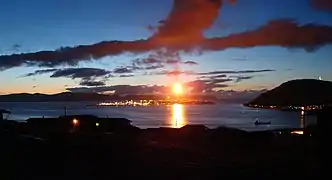
The construction of the large liquefied natural gas site on Melkøya (island) just off Hammerfest, which will process natural gas from Snøhvit, is the most expensive construction project in the history of Northern Norway. This project has resulted in an economic boom and new optimism in Hammerfest in recent years, a stark contrast to the economic downhill and negative population growth most other municipalities in Finnmark are experiencing.[61][62][63][64] After the opening of natural gas production on Melkøya there have been some problems with significant smoke and soot pollution in the initial production phases.[65] Snøhvit is Europe's first export facility for liquefied natural gas.[66]
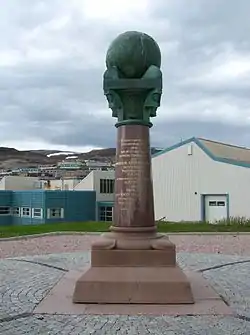
Hammerfest offers sport and commercial fishing, both sea and freshwater, as well as scuba diving. The northernmost glacier on the Norwegian mainland is a hiking destination. The town is a starting point for northern tours. There is a daily boat to the North Cape (Norwegian: Nordkapp). One chain of the Struve Geodetic Arc, now on the World Heritage List, is located at Fuglenes in Hammerfest.
Hammerfest is also a centre of Sami culture. Hammerfest is home to the Royal and Ancient Polar Bear Society (Norwegian: Isbjørnklubben); a museum displaying the history of Arctic hunting.
The newspaper Hammerfestingen is published in Hammerfest.
American author Bill Bryson begins his European travels in 1990, documented in his book Neither Here Nor There, with a visit to Hammerfest in order to see the Northern Lights, calling it "an agreeable enough town in a thank-you-God-for-not-making-me-live-here sort of way".[67]
Transportation
Hammerfest is connected to the main road network by Norwegian national road 94 which branches off from European route E6 at Skaidi in the neighbouring municipality of Kvalsund. The town is a port of call for the Hurtigruten ship route. Hammerfest also has Finnmark's third largest airport, Hammerfest Airport, opened 30 July 1974. Before the opening of the airport, the only air link to Hammerfest was by seaplane, the first route established in 1936.[68]
Reindeer problems
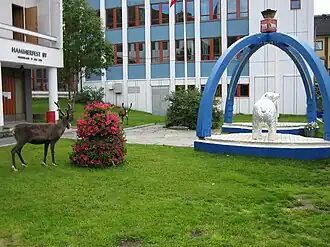
During the summer, massive reindeer herds migrate from their winter pastures in the inner parts of Finnmark to the coast. Among the islands inhabited by reindeer during the summer months is Kvaløya, the island on which Hammerfest town is located. For years many of the 2,500 to 3,000 reindeer in the area have been coming into the town itself, wandering in the streets and among the houses. Although popular with tourists, this has been less favourably received by the town's population, with people complaining of traffic disturbances and the dung and urine left by the animals. For hygienic reasons large sums of money have to be spent every year to clean up after the animals.[69] In response to the complaints the town authorities built a 20-kilometre-long (12 mi), 1.2-metre-tall (4 ft) fence encircling the town to keep the animals out.[70] However, as of the 2008 reindeer season, the fence had proven ineffective, with reindeer managing to pass through on road crossings, despite the presence of electrified grates embedded in the ground.[71] The problem continues – the mayor, Alf E. Jakobsen, joked during the local election in 2011 that he was contemplating a career as a reindeer herder if he lost the vote.[72]
International relations
Twin towns – Sister cities
.jpg.webp)
Hammerfest is town twinned with the following foreign settlements:
Foreign consulates
Denmark,[79] Sweden,[80] Finland[81] and the Netherlands[82] have honorary consulates in Hammerfest.
Notable people
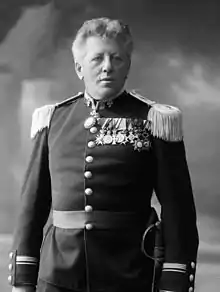
- Sir John Rice Crowe (1795–1877) an English businessman and diplomat, deputy vice-consul in Hammerfest and British consul in Finnmark, lived in Hammerfest
- Ole Olsen (1850–1927) a Norwegian organist, composer, conductor and military musician
- Adolf Lindstrøm (1866–1939) a Norwegian chef and polar explorer
- Paal Berg (1873–1968) a Norwegian politician, 12th Chief Justice of the Supreme Court, 1929 to 1946
- Charles Robertson (1875–1958), Norwegian Minister of Trade 1926–1928
- Jørgen Holmboe (1902–1979) a Norwegian-American meteorologist
- Per Møystad Backe (1914–1991) a Norwegian jurist, developed Scandinavian Airlines
- Annemarie Lorentzen (1921–2008) teacher in Hammerfest, politician and Norwegian ambassador to Iceland 1978 to 1985
- Knut Moe (1921–1989) a Norwegian resistance member in WWII and radio agent for the SIS
- Kåre Berg (1932–2009) a Norwegian professor in medical genetics, discovered the Lipoprotein(a)
- Sven Ullring (born 1935) a Norwegian engineer and businessperson
- Turi Josefsen (born 1936) a Norwegian-American businesswoman
- Kåre Kivijärvi (1938-1991) a Norwegian photographer, did photojournalistic work in Northern Norway
- Bjørn Sundquist (born 1948) a Norwegian actor, famous for TV, theatre and movie roles [83]
- Annelise Josefsen (born 1949), Norwegian-Sami artist
- Bodil Niska (born 1954) a Norwegian jazz musician on saxophone, grew up in Hammerfest
- Samoth (born 1974) as Thomas Thormodsæter Haugen, a black metal musician and multi-instrumentalist
- Gunnar Garfors (born 1975) a Norwegian traveller, author, media professional and public speaker
- Máret Ánne Sara (born 1983) a Sami artist and author, lives and works in Kautokeino
Sport
- Fred Børre Lundberg (born 1969) a Nordic skier, won two team silver medals and one team gold medal at the Winter Olympics and an individual gold at the 1994 Winter Olympics
- Christine Bøe Jensen (born 1975) a former footballer, team gold medallist at the 2000 Summer Olympics
Bibliography
- Brooke, Arthur de Capell (1826). A winter in Lapland and Sweden, with various observations relating to Finmark and its inhabitants. John Murray.
References
- ↑ "Navn på steder og personer: Innbyggjarnamn" (in Norwegian). Språkrådet.
- ↑ "Forskrift om målvedtak i kommunar og fylkeskommunar" (in Norwegian). Lovdata.no.
- ↑ Bolstad, Erik; Thorsnæs, Geir, eds. (26 January 2023). "Kommunenummer". Store norske leksikon (in Norwegian). Kunnskapsforlaget.
- ↑ Statistisk sentralbyrå. "Table: 06913: Population 1 January and population changes during the calendar year (M)" (in Norwegian).
- ↑ Statistisk sentralbyrå. "09280: Area of land and fresh water (km²) (M)" (in Norwegian).
- ↑ Jukvam, Dag (1999). "Historisk oversikt over endringer i kommune- og fylkesinndelingen" (PDF) (in Norwegian). Statistisk sentralbyrå. Archived (PDF) from the original on 1 September 2012. Retrieved 2 February 2013.
- ↑ "Om sammenslåingen" (in Norwegian). Nye Hammerfest kommune. Archived from the original on 18 June 2018. Retrieved 18 June 2018.
- ↑ Mæhlum, Lars, ed. (24 December 2019). "Troms og Finnmark". Store norske leksikon (in Norwegian). Kunnskapsforlaget. Archived from the original on 27 October 2019. Retrieved 26 December 2019.
- ↑ "Fylkesinndelingen fra 2024" (in Norwegian). Regjeringen.no. 5 July 2022.
- ↑ Kortner, Olaf; et al. (1993). Aschehoug og Gyldendals store norske leksikon (in Norwegian). Vol. 6. Oslo: Kunnskapsforlaget. p. 354. ISBN 82-573-0581-2. Archived from the original on 1 June 2022. Retrieved 24 December 2009.
- ↑ "Hammerfest kommune – Hámmerfeastta suohkan" (in Norwegian). Nye Hammerfest kommune. Archived from the original on 19 June 2018. Retrieved 18 June 2018.
- ↑ "Stadnamn og rettskriving" (in Norwegian). Kartverket. Retrieved 19 November 2023.
- ↑ Jakobsen, Bjørn Egil (1 March 2018). "Det samiske navnet kan bli Hámmerfeasta suohkan [sic]" [New Sámi Name: "Hámmerfeastta suohkan"?]. Hammerfestingen (in Norwegian Bokmål). Vol. 8, no. 9. p. 8.
- ↑ "Civic heraldry of Norway - Norske Kommunevåpen". Heraldry of the World. Retrieved 21 January 2023.
- ↑ "Hammerfest, Finnmark". Flags of the World. Retrieved 21 January 2023.
- ↑ "Forskrifter for bruk av Hammerfest kommunes våpen". Hammerfest kommune (in Norwegian). 21 April 2022. Retrieved 21 January 2023.
- ↑ MacEacheran, Mike (4 December 2017). "The Norwegian town the world tried to erase". British Broadcasting Corporation (BBC). Archived from the original on 9 December 2017. Retrieved 8 December 2017.
- ↑ Proctor, James (2012). Lapland. Bradt Travel Guides. Chalfont St Peters, Buckinghamshire, England: Globe Pequot Press (Rowman & Littlefield). p. 170. ISBN 978-1-84162-365-8.
- ↑ Knudsen, Svein Aage (2006). Ubåtkrig - tyske ubåtmannskaper i norske farvann 1940-1945 (in Norwegian). Arendal: DANOR Forlag AS. p. 133.
- ↑ Hafsten, Bjørn; Larsstuvold, Ulf; Olsen, Bjørn; Stenersen, Sten (1991). Flyalarm - luftkrigen over Norge 1939-1945 (in Norwegian) (1st ed.). Oslo: Sem og Stenersen. p. 319. ISBN 82-7046-058-3.
- ↑ Gamst, Thorbein (1984). Finnmark under Hakekorset - Festung Finnmark (in Norwegian). Arendal: Agdin Forlag. pp. 137–141.
- 1 2 Ringdal, Nils Johan (1995). "Hammerfest". In Dahl; Hjeltnes; Nøkleby; Ringdal; Sørensen (eds.). Norsk krigsleksikon 1940-45 (in Norwegian). Oslo: Cappelen. p. 153. ISBN 82-02-14138-9. Archived from the original on 15 March 2012. Retrieved 27 January 2010.
- ↑ Lawson, Siri Holm. "D/S Tanahorn". Warsailors.com. Archived from the original on 7 January 2010. Retrieved 27 January 2010.
- ↑ Lawson, Siri Holm. "M/S Brynilen". Warsailors.com. Archived from the original on 25 February 2010. Retrieved 27 January 2010.
- ↑ "Tysk mine på 300 kilo sprengt". Finnmark Dagblad (in Norwegian). Archived from the original on 11 June 2008. Retrieved 9 June 2008.
- ↑ "Byer i Norge" (in Norwegian). Archived from the original on 7 March 2012. Retrieved 27 March 2012.
- ↑ Mellgren, Doug (Associated Press) (19 March 1998). "It's a matter of latitude: Norwegians trade barbs in northernmost-town spat". Seattle Post-Intelligencer. Retrieved 16 March 2010.
- ↑ "Avalanches in Norway" (in Norwegian). Norwegian Geotechnical Institute. Archived from the original on 28 December 2006.
- ↑ "Observations and weather statistics". Norwegian Meteorological Institute. Retrieved 8 October 2023.
- ↑ "EKlima". Archived from the original on 28 January 2021. Retrieved 31 January 2021.
- ↑ "Hammerfest (June 2022)". yr.no (in Norwegian). Norwegian Meteorological Institute. Archived from the original on 16 October 2023. Retrieved 16 October 2023.
- ↑ "Hammerfest Climate Normals 1991-2020". National Oceanic and Atmospheric Administration. Archived from the original on 8 October 2023. Retrieved 8 October 2023.
- ↑ Hansen, Tore; Vabo, Signy Irene, eds. (20 September 2022). "kommunestyre". Store norske leksikon (in Norwegian). Kunnskapsforlaget. Retrieved 14 October 2022.
- ↑ "Kommunestyrevalg 2023 - Finnmark Finnmárku". Valgdirektoratet. Retrieved 4 January 2024.
- ↑ "Tall for Norge: Kommunestyrevalg 2019 - Troms og Finnmark". Valg Direktoratet. Retrieved 21 October 2019.
- 1 2 3 4 "Table: 04813: Members of the local councils, by party/electoral list at the Municipal Council election (M)" (in Norwegian). Statistics Norway. Archived from the original on 19 April 2020. Retrieved 22 October 2019.
- ↑ "Tall for Norge: Kommunestyrevalg 2011 - Finnmark". Valg Direktoratet. Retrieved 21 October 2019.
- ↑ "Kommunestyrevalget 1995" (PDF) (in Norwegian). Oslo-Kongsvinger: Statistisk sentralbyrå. 1996. Archived (PDF) from the original on 20 September 2014. Retrieved 18 March 2020.
- ↑ "Kommunestyrevalget 1991" (PDF) (in Norwegian). Oslo-Kongsvinger: Statistisk sentralbyrå. 1993. Archived (PDF) from the original on 22 May 2015. Retrieved 18 March 2020.
- ↑ "Kommunestyrevalget 1987" (PDF) (in Norwegian). Oslo-Kongsvinger: Statistisk sentralbyrå. 1988. Archived (PDF) from the original on 19 October 2014. Retrieved 18 March 2020.
- ↑ "Kommunestyrevalget 1983" (PDF) (in Norwegian). Oslo-Kongsvinger: Statistisk sentralbyrå. 1984. Archived (PDF) from the original on 19 October 2014. Retrieved 18 March 2020.
- ↑ "Kommunestyrevalget 1979" (PDF) (in Norwegian). Oslo: Statistisk sentralbyrå. 1979. Archived (PDF) from the original on 29 September 2014. Retrieved 18 March 2020.
- ↑ "Kommunevalgene 1975" (PDF) (in Norwegian). Oslo: Statistisk sentralbyrå. 1977. Archived (PDF) from the original on 15 March 2016. Retrieved 18 March 2020.
- ↑ "Kommunevalgene 1972" (PDF) (in Norwegian). Oslo: Statistisk sentralbyrå. 1973. Archived (PDF) from the original on 21 April 2016. Retrieved 18 March 2020.
- ↑ "Kommunevalgene 1967" (PDF) (in Norwegian). Oslo: Statistisk sentralbyrå. 1967. Archived (PDF) from the original on 21 April 2016. Retrieved 18 March 2020.
- ↑ "Kommunevalgene 1963" (PDF) (in Norwegian). Oslo: Statistisk sentralbyrå. 1964. Archived (PDF) from the original on 21 April 2016. Retrieved 18 March 2020.
- ↑ "Kommunevalgene og Ordførervalgene 1959" (PDF) (in Norwegian). Oslo: Statistisk sentralbyrå. 1960. Archived (PDF) from the original on 17 March 2016. Retrieved 18 March 2020.
- ↑ "Kommunevalgene og Ordførervalgene 1955" (PDF) (in Norwegian). Oslo: Statistisk sentralbyrå. 1957. Archived (PDF) from the original on 14 February 2020. Retrieved 18 March 2020.
- ↑ "Kommunevalgene og Ordførervalgene 1951" (PDF) (in Norwegian). Oslo: Statistisk sentralbyrå. 1952. Archived (PDF) from the original on 17 March 2016. Retrieved 18 March 2020.
- ↑ "Kommunevalgene og Ordførervalgene 1947" (PDF) (in Norwegian). Oslo: Statistisk sentralbyrå. 1948. Archived (PDF) from the original on 16 March 2016. Retrieved 18 March 2020.
- ↑ "Kommunevalgene og Ordførervalgene 1945" (PDF) (in Norwegian). Oslo: Statistisk sentralbyrå. 1947. Archived (PDF) from the original on 25 August 2014. Retrieved 18 March 2020.
- ↑ "Kommunevalgene og Ordførervalgene 1937" (PDF) (in Norwegian). Oslo: Statistisk sentralbyrå. 1938. Archived (PDF) from the original on 6 March 2016. Retrieved 18 March 2020.
- ↑ "Kommunevalgene og Ordførervalgene 1934" (PDF) (in Norwegian). Oslo: Statistisk sentralbyrå. 1935. Archived (PDF) from the original on 5 March 2016. Retrieved 18 March 2020.
- ↑ "Kommunevalgene og Ordførervalgene 1931" (PDF) (in Norwegian). Oslo: Statistisk sentralbyrå. 1932. Archived (PDF) from the original on 21 April 2016. Retrieved 18 March 2020.
- ↑ "Kommunevalgene og Ordførervalgene 1928" (PDF) (in Norwegian). Oslo: Statistisk sentralbyrå. 1929. Archived (PDF) from the original on 21 April 2016. Retrieved 18 March 2020.
- ↑ "Kommunevalgene og Ordførervalgene 1925" (PDF) (in Norwegian). Oslo: Statistisk sentralbyrå. 1926. Archived (PDF) from the original on 25 August 2014. Retrieved 18 March 2020.
- ↑ "Kommunevalgene og Ordførervalgene 1922" (PDF) (in Norwegian). Oslo: Statistisk sentralbyrå. 1923. Archived (PDF) from the original on 21 April 2016. Retrieved 18 March 2020.
- ↑ Jacobsen, Ragnvald (1974). Bankens virke, byens vekst: Hammerfest sparekasses jubileumsbok (in Norwegian). Hammerfest. ISBN 9788271310059.
{{cite book}}: CS1 maint: location missing publisher (link) - ↑ Sivertsen, Jørgen (1973). Hammerfest: 1789-1914 (in Norwegian). Hammerfest kommune. ISBN 9788271310011.
- ↑ "Terje Rogde er ordfører". NRK Troms og Finnmark (in Norwegian). Retrieved 4 January 2024.
- ↑ Blask, Sarah (4 December 2007). "Boomtown on the Barents". The Smart Set. Archived from the original on 5 March 2008. Retrieved 20 March 2008.
- ↑ Mouawad, Jad (9 October 2007). "A Quest for Energy in the Globe's Remote Places". The New York Times. Archived from the original on 18 October 2015. Retrieved 4 May 2010.
- ↑ Krauss, Clifford (10 October 2005). "As Polar Ice Turns to Water, Dreams of Treasure Abound". The New York Times. Archived from the original on 23 April 2009. Retrieved 4 May 2010.
- ↑ Duval-Smith, Alex (27 November 2005). "Arctic booms as climate change melts polar ice cap". The Observer. London. Archived from the original on 14 September 2017. Retrieved 11 December 2016.
- ↑ Berglund, Nina (31 August 2007). "'Snow White' opening clouded by soot over Hammerfest". Aftenposten. Archived from the original on 24 May 2011.
- ↑ "Scheduled shutdown on Snoehvit". The Norway Post. 6 October 2008. Retrieved 6 October 2008.
- ↑ Bryson, Bill (1998). Neither Here Nor There: Travels in Europe. Black Swan. ISBN 978-0-552-99806-2.
- ↑ "North to Hammerfest". Time. 8 June 1936. Archived from the original on 4 November 2007.
- ↑ Fouché, Gwladys (26 June 2006). "The rampaging reindeer of Hammerfest". The Guardian. London. Archived from the original on 27 October 2016. Retrieved 11 December 2016.
- ↑ Purvis, Andrew (25 September 2007). "Reindeer Games in Norway". Time. Archived from the original on 3 November 2012.
- ↑ Palm, Eirik (2 May 2008). "1-0 til Rudolf". Finnmark Dagblad (in Norwegian). Archived from the original on 4 May 2008. Retrieved 23 June 2008.
- ↑ "Reindeers still visiting town in 2011". Archived from the original on 25 April 2012. Retrieved 26 October 2011.
- ↑ "Cities in the counties of Norrbotten and Västerbotten and their twin-cities in Finland, Norway and Russia" (PDF). The Barents portal. April 2004. Archived from the original (PDF) on 9 March 2006. Retrieved 8 December 2008.
- 1 2 "Vennskapsamarbeid" (in Norwegian). Norden.no. Archived from the original on 27 September 2007.
- ↑ "Welcome to Kola village". Kola Travel. Archived from the original on 15 May 2015. Retrieved 8 December 2008.
- ↑ Hammerfest, Norway
- ↑ "Alaska's Sister States & Sister Cities". Gov.state.ak. Archived from the original on 5 February 2012.
- ↑ "Tornio Twin Cities". Tornio.fi. Archived from the original on 22 February 2012. Retrieved 8 December 2008.
- ↑ "Danish consulates in Norway, A-K" (in Danish). Ministry of Foreign Affairs of Denmark. Archived from the original on 14 February 2010.
- ↑ "Honorary Consulate of Sweden, Hammerfest". Government Offices of Sweden. Archived from the original on 5 June 2011. Retrieved 19 March 2008.
- ↑ "Finland´s Honorary Consulate, Hammerfest". Ministry for Foreign Affairs of Finland. Archived from the original on 16 July 2011.
- ↑ "Dutch Consulate in Hammerfest, Norway". Embassies/Consulates in Norway. Archived from the original on 24 September 2010. Retrieved 19 March 2008.
- ↑ IMDb Database Archived 2020-09-06 at the Wayback Machine retrieved 19 August 2020
Notes
- ↑ Regarding the temperature data of Hammerfest, the data from 1957 to 1987 was recorded at Hammerfest Radio, and the temperature data from 2002 to the present was recorded at Hammerfest Airport.
- ↑ Extreme snow depth, precipitation and precipitation days 1961-90, dew point and humidity 1991-2020
External links
- Municipal fact sheet Archived 21 August 2017 at the Wayback Machine from Statistics Norway (in Norwegian)
- Webcam Hammerfest
 Hammerfest travel guide from Wikivoyage
Hammerfest travel guide from Wikivoyage- Information from Statoil about the Snøhvit LNG construction
- Tromsø University Museum: Maritime hunter - fishers through 10,000 years at Melkøya
- Hammerfest official tourist information
- Finnmark University College
- Arctic booms as climate change melts polar ice cap
- Power station using tidal current as energy in Kvalsund
- New oil field discovered only 45 km (28 mi) off the coast
- Goliat oil field larger than previously thought
- Information about the planned natural gas power plant with CO2 reduction (in Norwegian)

